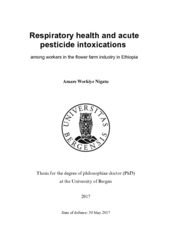| dc.description.abstract | Background: The flower industry in Ethiopia is a rapidly growing economic activity involving tens of thousands of workers. On these farms, roses are cultivated inside greenhouses, which are characterized by elevated temperature, humidity, poor ventilation and frequent use of pesticides. Pesticides of different types are widely used by the flower industry in Ethiopia to enhance the growth of flowers. Workers in the flower industry are frequently exposed to organic dust from the flowers and the soil, including endotoxins, and to pesticides, which may result in adverse health effects. In addition, residents in the immediate area may risk increased exposure to pesticides through the proximity of their homes to the flower farms. Several studies have shown a high prevalence of respiratory symptoms and acute pesticide intoxications among agricultural workers. Few of these studies focus on greenhouse workers. Despite its great importance to the country’s economy, the working conditions and health status of the workers in the Ethiopian flower industry are not thoroughly documented. Objectives: The aims of this study were to describe working conditions on flower farms, to determine personal dust and endotoxin exposure levels, assess self-reported symptoms and acute pesticide intoxications (API), and to study respiratory inflammation by measuring exhaled nitric oxide among flower farm workers and residents living close to the farms. In addition, we aimed to determining work-related risk factors of API. Methods and materials: This project was conducted via three separate studies between 2012 and 2014 in selected Ethiopian flower farms and among the residents grouped according to their living proximity to one of the flower farms. In the first study, a work place survey was performed on three flower farms using a structured checklist. In addition, interviews were made, obtaining respiratory, neurological and dermal symptoms using the British Medical Research Council (BMRC) questionnaire, and a standardized questionnaire instrument of subjective health complaints among flower farm workers (n=213) and a control group of supermarket workers (n=60). In the second study, respiratory symptoms were assessed in an interview using the BMRC questionnaire among 248 female workers in four flower farms. The mean age, and years at work for the participants were 24 and 2 years, respectively. Measurements of exhaled nitric oxide were performed according to the American Thoracic Society and European Respiratory Society recommendations (n=108) using a portable electrochemistry-based sensor. Full-shift personal exposure to endotoxin was measured in samples of “total” dust in the environment, collected from the workers’ breathing zone (n=75). In the third study the prevalence of API was assessed among residents (n=516) living in the surrounding area of a large flower farm. Participants (mean age 30 years) were grouped according to their residence proximity to a large flower farm; living within 5 km, and 5–12 km away, respectively, from the flower farm. In structured interviews, we asked participants to report their exposure to pesticides and if they had experienced health symptoms within 48 hours of the exposure to the pesticides during the previous year. Those who had experienced this, and reported two or more typical pesticide intoxication symptoms at the time, were considered as having had API. In addition, risk factors of API were assessed among the residents who were either flower farm workers or small-scale farmers (n=440). Results: Workers at the flower farms generally had higher prevalence of respiratory, neurological and dermal symptoms than controls. Female workers inside the greenhouses had significantly higher prevalence of chronic respiratory and dermal symptoms than women working outside the greenhouses. Limited access to personal protective equipment (PPE) and unsafe pesticide routines were observed in all the flower farms examined. Greenhouse workers had higher endotoxin exposure than workers outside greenhouses, but the levels were relatively low, compared to European standards. The concentration of FeNO ranged from 5 to 166 ppb with a GM of 14 ppb. Only two workers had FeNO concentrations above 50 ppb, a level that often indicates the presence of asthma. FeNO was not different among those working inside and outside the greenhouses. The residents who live nearby and worked on the flower farm had significantly higher prevalence of API (56%) than did the residents living nearby but who did not work in the flower farm (16%). Flower farm workers had a higher risk of API than did small-scale farmers (PR=4.5, 95% CI: 3.20, 6.35). Lack of safety training, not following pesticide label instructions and not bathing after pesticides were used were significant risk factors for API among flower farm workers. Among small-scale farmers, none of the risk factors were significantly associated with API. Conclusion: The study revealed a high prevalence of self-reported respiratory, dermal and neurological symptoms and API among the workers on the flower farms. Lack of pesticide safety training, not following pesticide labels and poor personal hygiene measures were significant risk factors associated with API among flower farm workers. Dust or endotoxin levels were low and inflammation in the airways of the workers was not revealed when measured by exhaled NO. | en_US |
